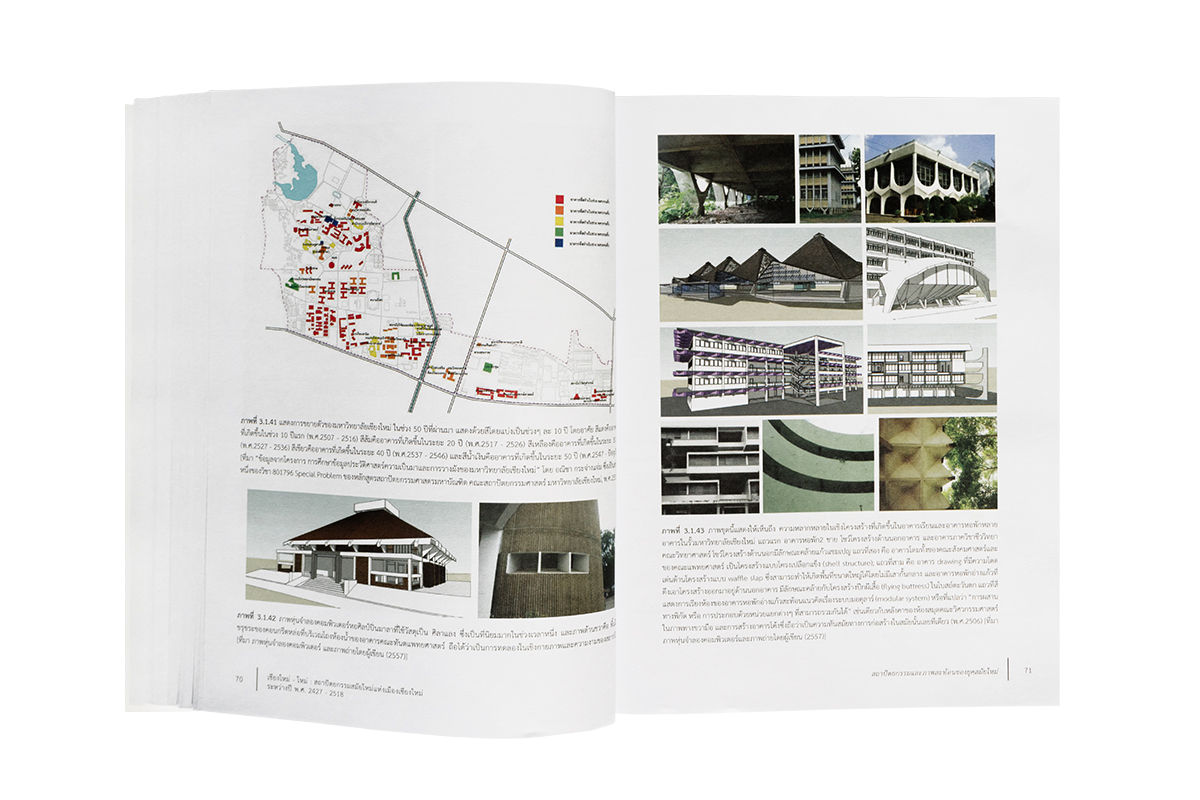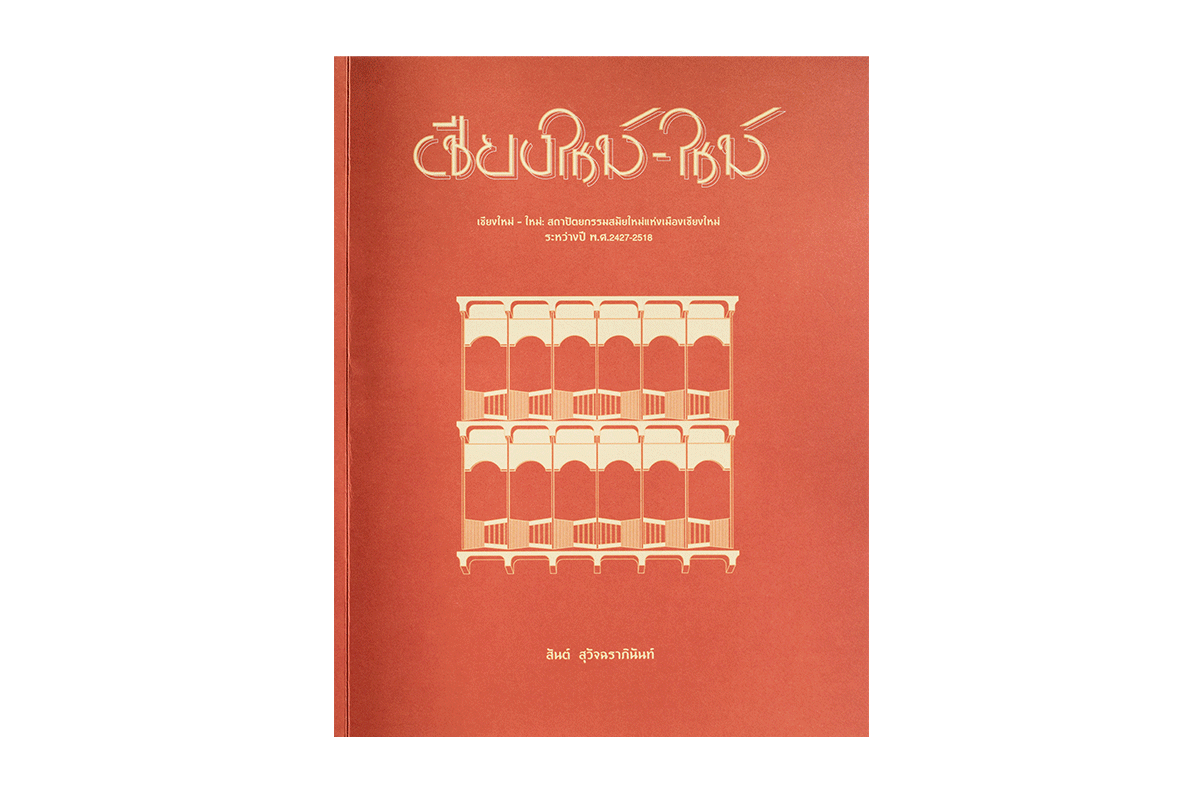“CHIANG MAI-MAI: MODERN ARCHITECTURE OF CHIANGMAI BETWEEN 1884-1975” IS A BOOK THAT BRINGS TOGETHER INFORMATION AND DATA FROM DIFFERENT DIMENSIONS AND ASPECTS OF RELATIONSHIPS AND CONNECTIONS TAKING PLACE WITHIN THE CONTEXT AND PHYSICALITY OF CHIANG MAI’S ARCHITECTURE
It is, therefore, understandable why the content of the book does not stop at architecture but also encompasses the reconciliation of the city’s urban context as it reveals how the modern architecture of Chiang Mai has been surrounded and influenced by conditions and situations in different periods of time. The interesting thing about the book lies in the author’s decision to present the development in four historical dimensions with the relocation of the population into the city as the core analysis. The four dimensions are essentially education and its close relationship with the coming of the missionary, the city’s economy being impacted by the migration of Chinese immigrants from the south of the People’s Republic of China, the political aspects which revolve around the clash in the dimension of space and the fight for the popular definition of urban space between the capital of Lanna, such as Chiang Mai and Bangkok as the center of Siam under the Absolute Monarchy State through governing mechanisms and infrastructure. This later leads to the issue regarding the coming of technology and the formation of the new role of industrial technologies including its impact on Chiang Mai’s society such as how the fire that burnt down Waroros Market led to the use of modern construction techniques and technologies. Such progress deserves further study and exploration from the way the presence of technology has changed the landscape of the city, the extent, dimensions and levels of the network of relationships it has created, and possible issues that this chain reaction has led to.
Additionally, a collection of buildings that the author studied and locates on the map as a part of the book’s appendix allows for readers to use the book as a guidebook to track down the interesting pieces of modern architecture in Chiang Mai. However, while the author is able to provide a well-rounded perception towards the development of Chiang Mai’s modern architecture, what the book is missing is an exploration into the contradiction and consistency between the city’s infrastructure and the forms that have been conceived from the design process of architectural projects. Certain parts of the appendix mention the issues but they are not as diverse as they should be. Furthermore, apart from the clear analysis that the author is able to break down, the reconciliation of the modernization process from within the architecture to search for a hidden fracture can be another approach that helps us to understand a lot more about the essence of the architecture amid the outside forces that come clashing. Nonetheless, it could be the contradiction of the projected image, logic of the structure and technological limitations. If that is the case, the series of conflicts of this nature eventually reveal a series of relationships of Chiang Mai’s very own ‘modernization process’ that utilizes built structures in the city’s urban fabric as the initial ‘text’ of the interpretation.
Sant Suwatcharapinun, Renoo Wichasin
Chiang Mai university Press, 2016
Paperback, 280 pages, 21.2×26.8 cm
isbn 978-6-16398-078-6

หนังสือ “เชียงใหม่-ใหม่: สถาปัตยกรรมสมัยใหม่แห่งเมืองเชียงใหม่ ระหว่างปี พ.ศ. 2427-2518” เป็นแหล่งรวบรวมข้อมูลความสัมพันธ์ในมิติต่างๆ ที่เกิดขึ้นในเมืองเชียงใหม่ ดังนั้น เนื้อหาในเล่มจึงไม่ได้หยุดอยู่แค่เรื่องที่เกี่ยวกับสถาปัตยกรรม แต่เป็นการคลี่คลายตัวบริบทของเมืองออกมาให้เห็นว่าสถาปัตยกรรมสมัยใหม่ในเมืองเชียงใหม่นั้น แวดล้อมไปด้วยเงื่อนไขและสถานการณ์อย่างไรในแต่ละช่วงเวลา ความน่าสนใจของหนังสืออยู่ที่ผู้เขียนเลือกที่จะคลี่คลายพัฒนาการในสี่มิติทางประวัติศาสตร์ที่มีการเคลื่อนย้ายของคนเข้ามาเป็นแกนหลักในการวิเคราะห์ โดยมิติทั้งสี่ที่ว่า ก็คือด้านการศึกษาทีโยงกับการเข้ามาของมิชชันนารี ด้านเศรษฐกิจที่สัมพันธ์กับการอพยพย้ายถิ่นของชาวจีนจากตอนใต้ของสาธารณรัฐประชาชนจีน ด้านการเมืองการปกครองที่เป็นเนื้อหาที่ว่าด้วยการปะทะกันในมิติของพื้นที่และการชิงความหมายของพื้นที่ในเมือง ระหว่างเมืองเชียงใหม่ในฐานะที่เป็นศูนย์กลางของอาณาจักรล้านนากับกรุงเทพฯ ในฐานะที่เป็นศูนย์กลางของสยามและในฐานะที่เป็นรัฐสมบูรณาญาสิทธิราชย์ ผ่านกลไกการปกครอง และด้านโครงสร้างพื้นฐานของเมือง ซึ่งได้จุดประกายเปิดประเด็นที่กว้างขวางไปกว่านั้น นั่นคือการแทรกตัวเข้ามาของเทคโนโลยี และการก่อตัวของบทบาทใหม่ที่เทคโนโลยีแบบเครื่องจักรมีต่อสังคมเชียงใหม่ อย่างเช่น เหตุการณ์ไฟไหม้ตลาดวโรรสที่นำไปสู่การนำเทคนิคการก่อสร้างและเทคโนโลยีใหม่เข้ามา ซึ่งเป็นเรื่องที่น่าติดตามต่อ และขยายผลต่อไปอย่างมากว่าเมื่อเทคนิคและเทคโนโลยีเหล่านี้เข้ามาแล้วนั้น มันได้เปลี่ยนภูมิทัศน์ของเมืองไปกี่ชั้นมิติ เกิดเป็นระบบโครงข่ายความสัมพันธ์ที่ซ้อนกันกี่ระดับและส่งผลกระทบแบบห่วงลูกโซ่ไปสู่ประเด็นใดต่อไปได้บ้าง เป็นต้น
นอกจากนี้ การรวบรวมงานสถาปัตยกรรมที่ผู้เขียนได้ทำาการศึกษาพร้อมการกำหนดจุดในแผนที่ไว้ในภาคผนวกของหนังสือ ทำให้คนอ่านสามารถใช้หนังสือเล่มนี้เป็นเหมือนไกด์บุ๊ค เพื่อตามแกะรอยงานสถาปัตยกรรมสมัยใหม่ในเชียงใหม่ได้ด้วย อย่างไรก็ดี ถึงแม้ผู้เขียนจะพยายามให้มุมมองของสถาปัตยกรรมสมัยใหม่ในเมืองเชียงใหม่ที่มีความกลมในมิติของพัฒนาการออกมาได้เป็นอย่างดี แต่ประเด็นเรื่องความสอดคล้องหรือย้อนแย้งระหว่างโครงสร้างกับรูปทรงที่เกิดขึ้นในกระบวนการออกแบบงานสถาปัตยกรรมแต่ละชิ้นกลับจางหายไป แม้มีการนำาเสนออยู่บ้าง แต่ไม่มากนักในส่วนภาคผนวก ทั้งนี้ กระบวนการเข้าสู่สมัยใหม่นั้น นอกจากการวิเคราะห์ดังที่ผู้เขียนได้แจกแจงออกมาอย่างชัดเจนแล้วนั้น การคลี่คลายกระบวนการดังกล่าวออกมาจากภายในตัวสถาปัตยกรรมเองเพื่อหารอยแยกอีกแห่งที่ซ่อนตัวอยู่ก็อาจจะเป็นอีกมุมมองที่ช่วยให้เราเข้าใจเนื้อในของตัวสถาปัตยกรรมท่ามกลางแรงปะทะจากภายนอกได้อีกมาก ทั้งนี้ มันอาจจะเป็นความขัดแย้งระหว่างภาพลักษณ์ภายนอกที่ปรากฏ ตรรกะของโครงสร้างและเงื่อนไขข้อจำกัดทางเทคโนโลยีก็ได้ ซึ่งในกรณีนั้น ชุดความขัดแย้งในลักษณะนี้ย่อมเผยให้เห็นถึงชุดความสัมพันธ์ของ “กระบวนการเข้าสู่สมัยใหม่” ในแบบของเชียงใหม่เองที่ใช้ตัวสิ่งปลูกสร้างที่มีอยู่ในพื้นที่เมืองเป็น “ตัวบท” ตั้งต้นในการตีความ
TEXT & PHOTO : KANOKWAN TRAKULYINGCHAROEN
cmupress.cmu.ac.th

